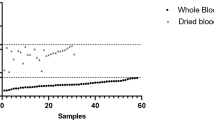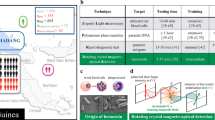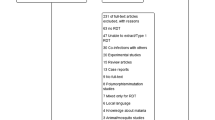Abstract
WHO–Regional Office for the Western Pacific/TDR
This is a preview of subscription content, access via your institution
Access options
Subscribe to this journal
Receive 12 print issues and online access
$209.00 per year
only $17.42 per issue
Buy this article
- Purchase on Springer Link
- Instant access to full article PDF
Prices may be subject to local taxes which are calculated during checkout
Similar content being viewed by others
References
WHO. The Use of Malaria Rapid Diagnostic Tests [online], (WHO Regional Office for the Western Pacific, Manila, Philippines, 2004).
WHO. New Perspectives: Malaria Diagnosis. Report of a joint WHO/USAID Informal Consultation 25–27 October 1999 [online], (WHO, Geneva, 2000).
WHO. Malaria Rapid Diagnosis: Making it Work. Meeting Report 20–23 January 2003 [online] WHO, Manila, Philippines, 2003).
Humar, A. et al. Parasight F test compared with the polymerase chain reaction and microscopy for the diagnosis of Plasmodium falciparum malaria in travelers. Am. J. Trop. Med. Hyg. 56, 44– 48 (1997).
Pieroni, P. et al. Comparison of the ParaSight-F test and the ICT Malaria Pf test with the polymerase chain reaction for the diagnosis of Plasmodium falciparum malaria in travellers. Trans. R. Soc. Trop. Med. Hyg. 92, 166– 169 (1998)
Quintana, M. et al. Malaria diagnosis by dipstick assay in a Honduran population with coendemic Plasmodium falciparum and Plasmodium vivax. Am. J. Trop. Med. Hyg. 59, 868– 871 (1998).
Lee, M. A. et al. A comparison of antigen dipstick assays with polymerase chain reaction (PCR) technique and blood film examination in the rapid diagnosis of malaria. Ann. Acad. Med. Singapore 28, 498– 501 (1999).
Carrasquilla, G. et al. Epidemiologic tools for malaria surveillance in an urban setting of low endemicity along the Colombian Pacific coast. Am. J. Trop. Med. Hyg. 62, 132– 137 (2000).
Parkes, R. et al. Comparison of a nested polymerase chain reaction–restriction fragment length polymorphism method, the PATH antigen detection method, and microscopy for the detection and identification of malaria parasites. Can. J. Microbiol. 47, 903– 907 (2001).
Zakeri, S. et al. Detection of malaria parasites by nested PCR in south-eastern Iran: evidence of highly mixed infections in Chahbahar district. Malaria J. 1, 2 (2002).
Bell, D. R. et al. False-positive results of a Plasmodium falciparum histidine-rich protein 2 — detecting malaria rapid diagnostic test due to high sensitivity in a community with fluctuating low parasite density. Am. J. Trop. Med. Hyg. 73, 1 (2005).
Oduola, A. M. et al. Plasmodium falciparum: evaluation of lactate dehydrogenase in monitoring therapeutic responses to standard antimalarial drugs in Nigeria. Exp. Parasitol. 87, 283– 289 (1997).
Moody, A. et al. Performance of the OptiMAL malaria antigen capture dipstick for malaria diagnosis and treatment monitoring at the Hospital for Tropical Diseases, London. Br. J. Haematol. 109, 891– 894 (2000).
Srinivasan, S. et al. Comparison of blood-film microscopy, the OptiMAL dipstick, Rhodamine-123 fluorescence staining and PCR, for monitoring antimalarial treatment. Ann. Trop. Med. Parasitol. 94, 227– 232 (2000).
Miller, R. S. et al. Following the course of malaria treatment by detecting parasite lactate dehydrogenase enzyme. Br. J. Haematol. 113, 558– 559 (2001).
Huong, N. M. et al. Comparison of three antigen detection methods for diagnosis and therapeutic monitoring of malaria: a field study from southern Vietnam. Trop. Med. Int. Health 7, 304– 308 (2002).
Moody, A. H. & Chiodini, P. L. Non-microscopic method for malaria diagnosis using OptiMAL IT, a second-generation dipstick for malaria pLDH antigen detection. Br. J. Biomed. Sci. 59, 228– 231 (2002).
Singh, N. et al. The hospital- and field-based performances of the OptiMAL test, for malaria diagnosis and treatment monitoring in central India. Ann. Trop. Med. Parasitol. 97, 5– 13 (2003).
Craig, M. H. & Sharp, B. L. Comparative evaluation of four techniques for the diagnosis of Plasmodium falciparum infections. Trans. R. Soc. Trop. Med. Hyg. 91, 279– 282 (1997).
Kilian, A. H. et al. Reliability of malaria microscopy in epidemiological studies: results of quality control. Trop. Med. Int. Health 5, 3– 8 (2000).
Kettelhut, M. M. et al. External quality assessment schemes raise standards: evidence from the UKNEQAS parasitology subschemes. J. Clin. Pathol. 56, 927– 932 (2003).
Wongsrichanalai, C. et al. Comparison of a rapid field immunochromatographic test to expert microscopy for the detection of Plasmodium falciparum asexual parasitemia in Thailand. Acta Trop. 73, 263– 273 (1999).
Mayxay, M. et al. Persistence of Plasmodium falciparum HRP-2 in successfully treated acute falciparum malaria. Trans. R. Soc. Trop. Med. Hyg. 95, 179– 182 (2001).
Mharakurwa, S. et al. Trial of the ParaSight-F test for malaria diagnosis in the primary health care system, Zimbabwe. Trop. Med. Int. Health 2, 544– 550 (1997).
Funk, M. et al. MalaQuick versus ParaSight F as a diagnostic aid in travellers' malaria. Trans. R. Soc. Trop. Med. Hyg. 93, 268– 272 (1999).
Kilian, A. H. et al. Application of the ParaSight-F dipstick test for malaria diagnosis in a district control program. Acta Trop. 72, 281– 293 (1999).
Trachsler, M. et al. Feasibility of a rapid dipstick antigen-capture assay for self-testing of travellers' malaria. Trop. Med. Int. Health 4, 442– 447 (1999).
Fryauff, D. et al. Performance of the OptiMAL assay for detection and identification of malaria infections in asymptomatic residents of Irian Jaya, Indonesia. Am. J. Trop. Med. Hyg. 63, 139– 145 (2000).
Jelinek, T. et al. Use of dipstick tests for the rapid diagnosis of malaria in nonimmune travelers. J. Travel Med. 7, 175– 179 (2000).
Tavrow, P. et al. Using Quality Design to Improve Malaria Rapid Diagnostic Tests in Malawi. Quality Assurance Project (QAP) for the United States Agency for International Development. [online], (Bethesda, MD, USA, 2000).
Whitty, C. J. M. et al. Self-testing for falciparum malaria with antigen-capture cards by travelers with symptoms of malaria. Am. J. Trop. Med. Hyg. 63, 295– 297 (2000).
Bell, D. et al. Diagnosis of malaria in a remote area of the Philippines: comparison of techniques and their acceptance by health workers and the community. Bull. WHO 79, 933– 941 (2001).
Mayxay, M. et al. Short communication: an assessment of the use of malaria rapid tests by village health volunteers in rural Laos. Trop. Med. Int. Health 9, 325– 329 (2004).
Tjitra, E. et al. Persistent ICT malaria P.f/P.v panmalarial and HRP2 antigen reactivity after treatment of Plasmodium falciparum malaria is associated with gametocytemia and results in false-positive diagnoses of Plasmodium vivax in convalescence. J. Clin. Microbiol. 39, 1025– 1031 (2001).
Hunt Cooke, A. et al. Comparison of a parasite lactate dehydrogenase-based immunochromatographic antigen detection assay (OptiMAL) with microscopy for the detection of malaria parasites in human blood samples. Am. J. Trop. Med. Hyg. 60, 173– 176 (1999).
Eisen, D. P. & Saul, A. Disappearance of pan-malarial antigen reactivity using the ICT Malaria P.f/P.v kit parallels decline of patent parasitaemia as shown by microscopy. Trans. R. Soc. Trop. Med. Hyg. 94, 169– 170 (2000).
WHO. Rapid Diagnostic Tests for Malaria: Methods Manual for Laboratory Quality Control Testing. Version 4. (World Health Organization, Manila, Philippines, in the press).
Desakorn, V. et al. Stage-dependent production and release of histidine-rich protein 2 by Plasmodium falciparum. Trans. R. Soc. Trop. Med. Hyg. 99, 517– 524 (2005).
Bechem, N. N. et al. Evaluation of a rapid test for histidine-rich protein 2 for diagnosis of Plasmodium falciparum infection in Cameroonian children. Trans. R. Soc. Trop. Med. Hyg. 93, 46 (1999).
Leke, R. F. et al. Detection of the Plasmodium falciparum antigen histidine-rish protein 2 in blood of pregnant women: implications for diagnosing placental malaria. J. Clin. Microbiol. 37, 2992– 2996 (1999).
Singer, L. M. et al. Evaluation of a malaria rapid diagnostic test for assessing the burden of malaria during pregnancy. Am. J. Trop. Med. Hyg. 70, 481– 485 (2004).
Acknowledgements
These guidelines are based primarily on recommendations for field trial design of the WHO Informal Consultation on Field Trials and Quality Assurance of Malaria Rapid Diagnostic Tests, 20–23 January, 2003, in Manila, Philippines, involving John Barnwell, Vincente Belizario, Martin Bubb, Deborah Burgess, Fernando Llanos-Zavalaga, Michael Makler, Anthony Moody, Elizabeth Streat, Chansuda Wongsrichanalai, Allan Magill, Jenny Luchavez, Mark Perkins, Andrea Bosman, Gustavo Bretas, Manas Kumar Banerjee, Krongthong Thimasarn, Edward Brian Doberstyn, Kevin Palmer, Bernard Tomas, Raman Velayudhan and David Bell some of whom have also contributed to later development. WHO acknowledges the further input of the TDR Diagnostics Evaluation Expert Panel, Daniel Masiga, Milton Tam, Paul Klatser, Guy Barnish, and others.
Author information
Authors and Affiliations
Supplementary information
Related links
Rights and permissions
About this article
Cite this article
Bell, D., Peeling, R. Evaluation of rapid diagnostic tests: malaria. Nat Rev Microbiol 4 (Suppl 9), S34–S38 (2006). https://doi.org/10.1038/nrmicro1524
Issue Date:
DOI: https://doi.org/10.1038/nrmicro1524
This article is cited by
-
Simple, rapid, and accurate malaria diagnostic platform using microfluidic-based immunoassay of Plasmodium falciparum lactate dehydrogenase
Nano Convergence (2020)
-
Detection of malaria parasites in dried human blood spots using mid-infrared spectroscopy and logistic regression analysis
Malaria Journal (2019)
-
Development of a film-based immunochromatographic microfluidic device for malaria diagnosis
Biomedical Microdevices (2019)
-
Performance of an ultra-sensitive Plasmodium falciparum HRP2-based rapid diagnostic test with recombinant HRP2, culture parasites, and archived whole blood samples
Malaria Journal (2018)
-
Automated microscopy for routine malaria diagnosis: a field comparison on Giemsa-stained blood films in Peru
Malaria Journal (2018)



